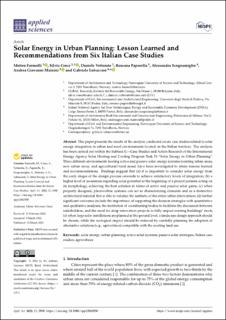| dc.contributor.author | Formolli, Matteo | |
| dc.contributor.author | Croce, Silvia | |
| dc.contributor.author | Vettorato, Daniele | |
| dc.contributor.author | Paparella, Rossana | |
| dc.contributor.author | Scognamiglio, Alessandra | |
| dc.contributor.author | Mainini, Andrea Giovanni | |
| dc.contributor.author | Lobaccaro, Gabriele | |
| dc.date.accessioned | 2023-03-01T13:02:30Z | |
| dc.date.available | 2023-03-01T13:02:30Z | |
| dc.date.created | 2022-04-09T16:18:11Z | |
| dc.date.issued | 2022 | |
| dc.identifier.citation | Applied Sciences. 2022, 12 (6), . | en_US |
| dc.identifier.issn | 2076-3417 | |
| dc.identifier.uri | https://hdl.handle.net/11250/3055016 | |
| dc.description.abstract | This paper presents the results of the analysis conducted on six case studies related to solar energy integration in urban and rural environments located on the Italian territory. The analysis has been carried out within the Subtask C—Case Studies and Action Research of the International Energy Agency Solar Heating and Cooling Program Task 51 “Solar Energy in Urban Planning”. Three different environments hosting active and passive solar energy systems (existing urban areas, new urban areas, and agricultural/rural areas) have been investigated to attain lessons learned and recommendations. Findings suggest that (a) it is important to consider solar energy from the early stages of the design process onwards to achieve satisfactory levels of integration; (b) a higher level of awareness regarding solar potential at the beginning of a project permits acting on its morphology, achieving the best solution in terms of active and passive solar gains; (c) when properly designed, photovoltaic systems can act as characterizing elements and as a distinctive architectural material that is able to valorize the aesthetic of the entire urban intervention; (d) further significant outcomes include the importance of supporting the decision strategies with quantitative and qualitative analyses, the institution of coordinating bodies to facilitate the discussion between stakeholders, and the need for deep renovation projects to fully impact existing buildings’ stock; (e) when large solar installations are planned at the ground level, a landscape design approach should be chosen, while the ecological impact should be reduced by carefully planning the adoption of alternative solutions (e.g., agrivoltaics) compatible with the existing land use. | en_US |
| dc.language.iso | eng | en_US |
| dc.publisher | MDPI | en_US |
| dc.rights | Navngivelse 4.0 Internasjonal | * |
| dc.rights.uri | http://creativecommons.org/licenses/by/4.0/deed.no | * |
| dc.title | Solar Energy in Urban Planning: Lesson Learned and Recommendations from Six Italian Case Studies | en_US |
| dc.title.alternative | Solar Energy in Urban Planning: Lesson Learned and Recommendations from Six Italian Case Studies | en_US |
| dc.type | Peer reviewed | en_US |
| dc.type | Journal article | en_US |
| dc.description.version | publishedVersion | en_US |
| dc.source.pagenumber | 0 | en_US |
| dc.source.volume | 12 | en_US |
| dc.source.journal | Applied Sciences | en_US |
| dc.source.issue | 6 | en_US |
| dc.identifier.doi | 10.3390/app12062950 | |
| dc.identifier.cristin | 2016395 | |
| dc.relation.project | Norges forskningsråd: 257660 | en_US |
| cristin.ispublished | true | |
| cristin.fulltext | original | |
| cristin.qualitycode | 1 | |

